Despite the presence of multiple militant groups in the Philippines who have made pledges of allegiance, or bayah, to Islamic State, the Philippine’ government and Armed Forces (AFP) have downplayed this threat. The statements they’ve made continuously ignore the reality of ISIS in the Philippines. This is partially due to the AFP deliberately downplaying the threat from ISIS by making false statements, something they’ve admitted to. At the same time, the Philippine government and the AFP have also managed to genuinely underestimate ISIS, likely in part due to the public downplaying of the threat as well as systematic intelligence failures.
Underestimating ISIS gave it the opportunity to stage major attacks that should have been preventable.
The Philippines has seen decades of conflict in the southern region of Mindanao, where the majority of the country’s Muslim minority live. Successive militant groups have fought the AFP in an attempt to form an independent state, and two major separatist militant groups have signed peace treaties with the government, agreeing to end fighting in return for various levels of autonomy.
However, splinter factions and other more recently founded organizations have led to a patchwork of extremist groups that continue to fight. Some of the most notable of these groups are the Bangsamoro Islamic Freedom Fighters, various Abu Sayyef Group battalions, and the Maute group.

Militants in the Philippines pledging allegiance to ISIS Philippine groups pledge allegiance to al-Baghdadi
In 2014 some Philippine groups began to give bayah to ISIS leader Abu Bakr al-Baghdadi, including senior Abu Sayyef commander Isnilon Hapilon, and BIFF. In the following years, more groups pledged allegiance to ISIS, including the Maute group.
ISIS later discussed the Philippines through various parts of their media apparatus. In 2014, the fifth edition of the group’s Dabiq magazine stated that groups in the Philippines had pledged allegiance to Baghdadi, and “announced the acceptance of the bay’āt from all of these groups and individuals.” Both the group’s spokesperson Abu Muhammad al-Adnani and Baghdadi himself made appeals to Filipinos to resist the “crusaders” and “rise against the apostate.”
In February and March 2016 ISIS’s official Al Furat Media released videos of Hapilon and commanders from several other groups pledging allegiance to Baghdadi. It should have been clear that these groups were now part of ISIS.
The Philippine government and AFP responded by stating that ISIS did not exist in the Philippines, with the then president Benigno Aquino saying, “It’s difficult to call them Islamic State groups.”
Philippine officials would for years treat Abu Sayyef, Maute, BIFF and other militant groups as if nothing had changed, seemingly failing to understand that they were now part of ISIS because they had pledged allegiance and it had been recognized.
In an effort to justify this position, officials made the distinction that, while the various militant groups in the southern Philippines may be ISIS-inspired, they were not ISIS-directed. They argued that while some individuals within Philippine groups, or even entire groups may be inspired by the extremist ideas of ISIS, they were not directed by ISIS in any way, implying there was no communication with ISIS and that groups did not receive orders from them.
This argument was flawed, as it ignored known communications between ISIS in the Philippines and its core in Iraq and Syria.
Videos and statements about groups in the Philippines were released by official ISIS outlets, suggesting a line of communication.
Filipinos had been known to travel to fight for ISIS in Iraq and Syria, often facilitated by communication with ISIS members. Communication with ISIS by militant groups in the Philippines is believed to have occurred as early as 2014, while certain militants, often Malaysians, enabled lines of communication between Philippine groups and ISIS in Iraq and Syria. Connections would deepen over time, with ISIS encouraging fighters to travel to the Philippines, giving direct orders to Filipino commanders, and even sending funds to support the activities of groups that had pledged allegiance to ISIS.
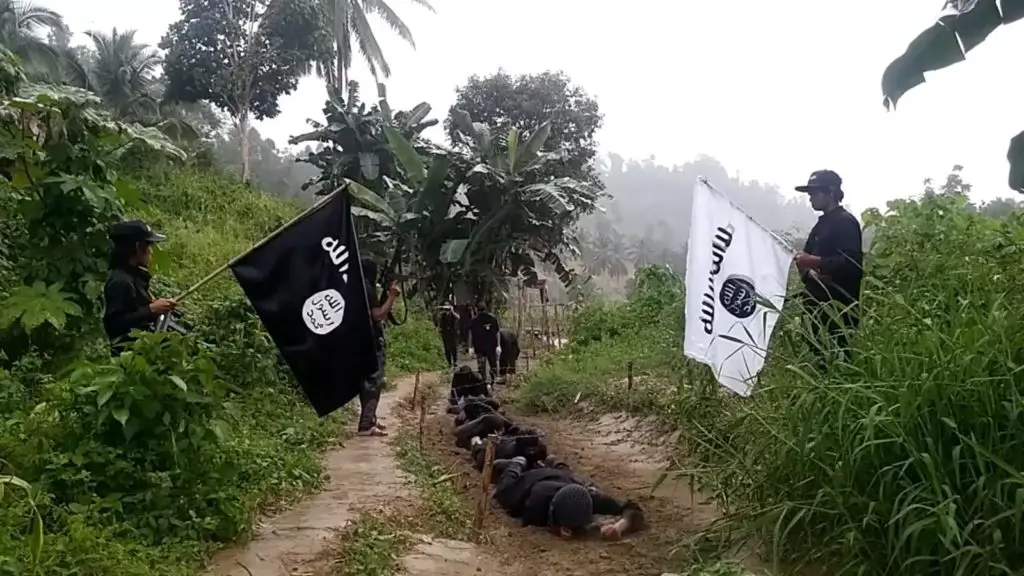
An ISIS training camp in the Philippines, taken from a video released in December 2015. Image: Long War Journal
Deepening connections
Even if this inspired-versus-directed distinction wasn’t false, it risked a dangerous complacency. The fact that these groups had all pledged allegiance to ISIS made them potentially more dangerous than before. It risked greater cooperation amongst historically fragmented groups with their support of ISIS overpowering geographic, clan, and ethnic divisions. There was also the risk of groups emulating the more extreme tactics of ISIS. Finally, in an attempt to win approval and recognition from ISIS, militant groups may have attempted to stage more significant attacks.
All of these things would later happen in the Philippines.
As deepening connections became more apparent, the Philippine government and the AFP continued to deny the presence of ISIS. In 2015, a video surfaced online showing what was described as a Philippines ISIS training camp.
In response, the Philippine National Security Adviser Cesar Garcia said, “ISIS has no training camps in the Philippines.”
This ignored evidence in the video itself, and in other videos and pictures showing militants training in the Philippines which were often uploaded to social media. In the minds of government officials, these were not ISIS camps because they did not view the militants operating them as part of ISIS. While the government denied the presence of ISIS, the camps were used to train new militants, people preparing to stage terror attacks, and even foreigners who had traveled to the Philippines for training before returning to their home countries.
The 2016 Basilan attack
In April 2016, a particularly bloody clash between militants and the AFP on the island of Basilan in the southern Philippines led to more denials about the role of ISIS. While attempting to target Hapilon and another commander, Furiji Indama, soldiers were ambushed, which led to a 10-hour gunfight that left 18 soldiers dead and more than 50 wounded, the worst losses in a single day for Philippine security forces that year.
ISIS claimed the incident through their Amaq news agency shortly afterwards, and a May 2016 edition of Al Naba reported on clashes in the Philippines over the previous few weeks, including the one in Basilan. Finally, an infographic released that June by Amaq talked about soldiers killed by ISIS forces, including those in the ambush.
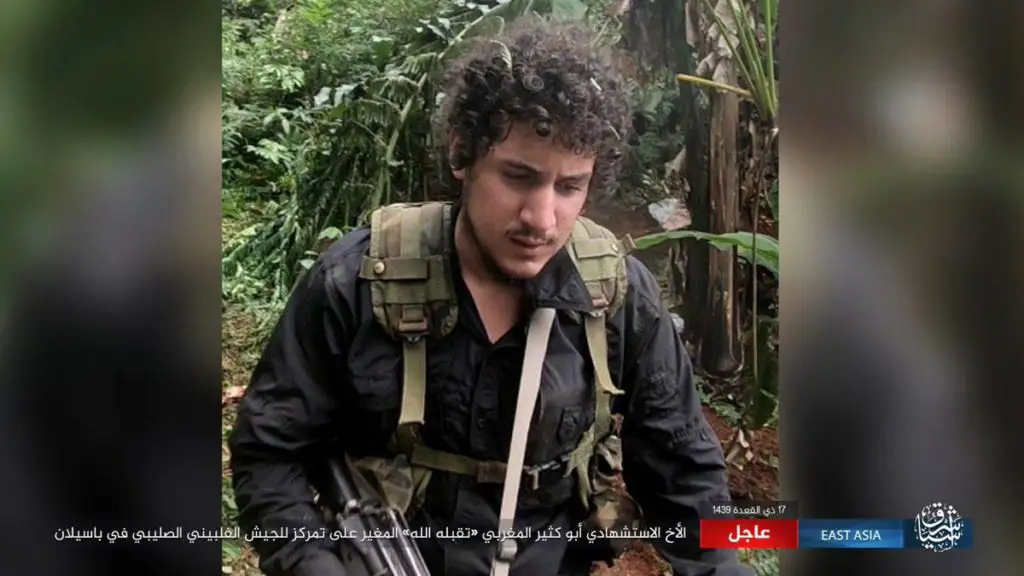
Photo released by ISIS showing the Moroccan man responsible for a suicide vehicle bomb attack in Basilan, the Philippines.
In response, the AFP denied ISIS had any role, saying that it was mere propaganda and that Abu Sayyef was responsible, again, seemingly ignoring that the group was by then part of ISIS. The fighting had been led by Hapilon himself, who that month ISIS publicly named as emir of all their forces in the Philippines. In addition, one of the slain militants was a Moroccan named Mohammad Khattab, who was reportedly building links between Abu Sayyef and ISIS.
Further indications of the connections between ISIS and groups in the Philippines came two months later when a video released by ISIS showed a Filipino, a Malaysian, and an Indonesian beheading three men in Syria. In the video they again recognized Hapilon as emir and called on jihadist groups in the Philippines to unify under him. They also urged people who could not travel to Syria to travel to the Philippines to fight for ISIS.
In response, military spokesperson Brigadier-General Restituto Padilla described the video as “propaganda.”
“People should not be bothered by this,” Padilla added.
The Battle of Marawi begins
Terrorist incidents continued through late 2016 and early 2017, the most notable being the September 2016 Davao city bombing and the brief takeover of the town of Butig two months later by the Maute group. These bolder attacks, sometimes involving multiple groups, in hindsight predicted what was to come.
On May 23, 2017, the AFP launched a raid to arrest Hapilon, who had been spotted in the city of Marawi, on Mindanao. Security forces stumbled into a city full of militants, triggering long-made plans by ISIS to seize the city. The botched raid by Filipino security forces had kicked off the Battle of Marawi.
An AFP statement released a day after the start of fighting said: “The situation in Marawi has stabilized,” and that “security forces are in full control of the situation.”
As the AFP denied the presences of ISIS, the group’s Amaq news agency released pictures from within Marawi showing ISIS fighters in broad daylight standing on streets, raising flags, and manning checkpoints unmolested by Philippine security forces.
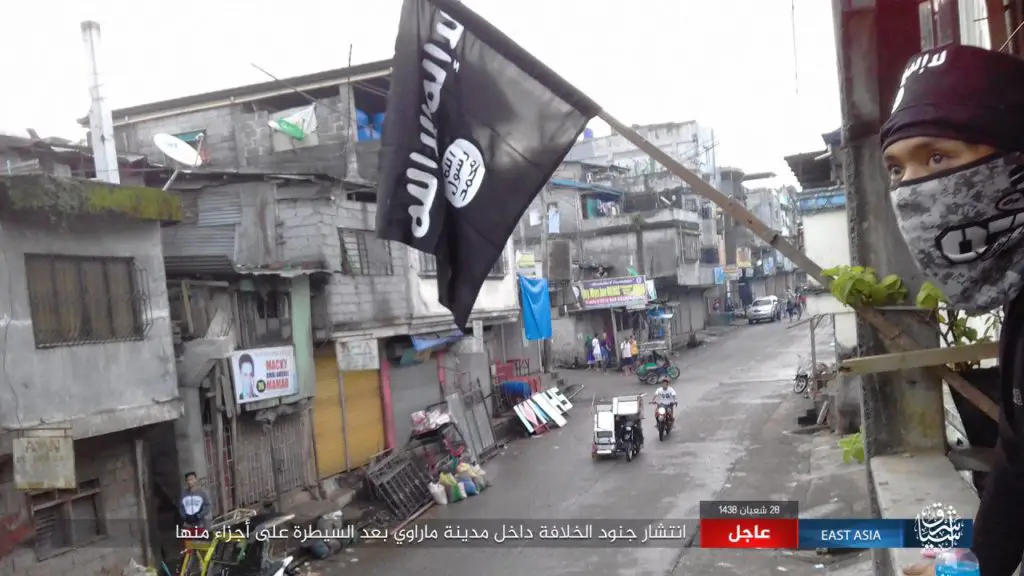
A screenshot from a video released by Amaq showing the ISIS presence in Marawi on May 24, 2017, a day after the Armed Forces of the Philippines said the security forces were in “full control.” Image: @abraxasspa/Twitter
The military claimed that there were only “sporadic clashes” from “harassment actions by terrorist sympathizers.” Most erroneously it was claimed that the militants in Marawi were “not members of the ISIS, but members of a local terrorist group.”
Two days later Secretary of National Defense Delfin Lorenzana said in a statement that the fighting would be over in a week at most, while AFP Chief of Staff General Eduardo Año said there were fewer than 100 militants in the city.
Throughout the battle similar false claims about the number of ISIS militants and how long until the city would be captured were repeated. There were even several instances when the military claimed the recapture of locations within the city despite them remaining firmly under ISIS control.
It would be five months of hard fighting before Marawi was recaptured, defying claims made by the government and security forces throughout. The battle saw the deaths of Hapilon and the leaders of the Maute group along with over 900 of their men, according to the government.
But victory came at a price. The city was left in ruins, 165 AFP soldiers were killed, more than 1,000 wounded, and ISIS achieved a significant propaganda victory.
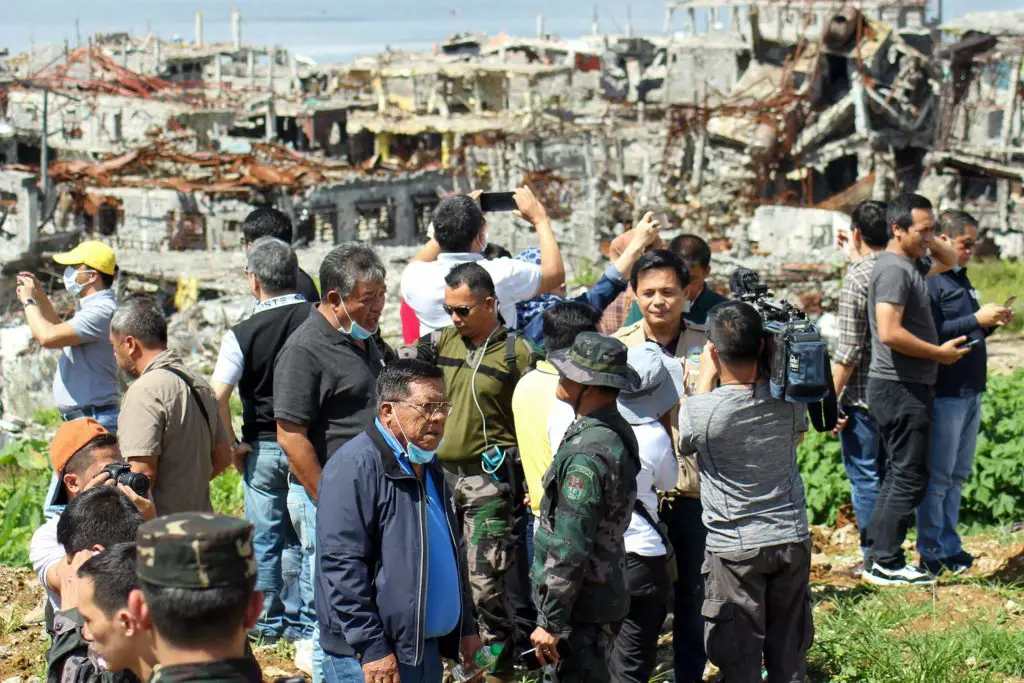
Local officials of Lanao del Sur province visit Ground Zero – also known as the Main Battle Area – in Marawi for the first time after the Battle of Marawi, November 14 2017. Image: Philippine Information Agency
Philippine military ordered to downplay ISIS threat
Due to the Battle of Marawi, President Rodrigo Duterte declared martial law across all of Mindanao. Documents submitted to the Supreme Court of the Philippines justifying the declaration revealed one reason why the AFP continuously made these false claims about ISIS.
It had been deliberate.
In a memorandum submitted to the Supreme Court on June 19, 2017, Año was quoted as saying the threat of ISIS was deliberately downplayed, and that “despite the actual threat of ISIS in the Philippines,” the AFP had been ordered to “downplay any news or information” relating to ISIS. The memo also said statements made about ISIS by the AFP were “propaganda.”
The justification for this was to not “give them recognition and fan the flames of rebellion” as well as to “encourage foreign investments and maintain confidence in the Philippine economy.”
Deliberately misleading the public about the threat from ISIS is a concerning prospect on its own, but worse, it doesn’t work as a full justification. Statements made by police and other officials appeared to show that the government also underestimated ISIS.
It is unknown if similar orders to those given to the AFP were given to police and other members of the government, but these statements also spanned two administrations as well as many departments.
That the government was not fully aware of the threat from ISIS is evident in private statements by Philippine officials that repeatedly ignored intelligence warnings; the AFP so often being wrong-footed against them; and multiple officials admitting to underestimating ISIS.
Duterte himself said officials were aware of the build-up of militants before the Battle of Marawi but “underestimated” the threat.
Major-General Carlito Galvez, head of the West Mindanao Command, said: “We knew this was coming,” and he has reportedly implied that Manila downplayed the threat.
Lorenzana, the defense secretary, said the government was “in denial” over the involvement of foreign ISIS fighters and that the army was unprepared.
While factors such as poor intelligence led the Philippine government and AFP to underestimate ISIS, publicly downplaying the threat likely reinforced this. Downplaying the threat was part of AFP’s psychological operations with the stated intentions to “mislead” and “influence the perceptions” of a group. These psychological operations were not targeted in any way, being made publicly and widely repeated by the media, often at face value.
This could have had the effect of making it harder for lower-level officials and members of the security services to take the threat seriously, while the inaccurate statements downplaying ISIS could also reinforce the poor intelligence members of the government and security officials received suggesting the group wasn’t as serious a threat as in reality.
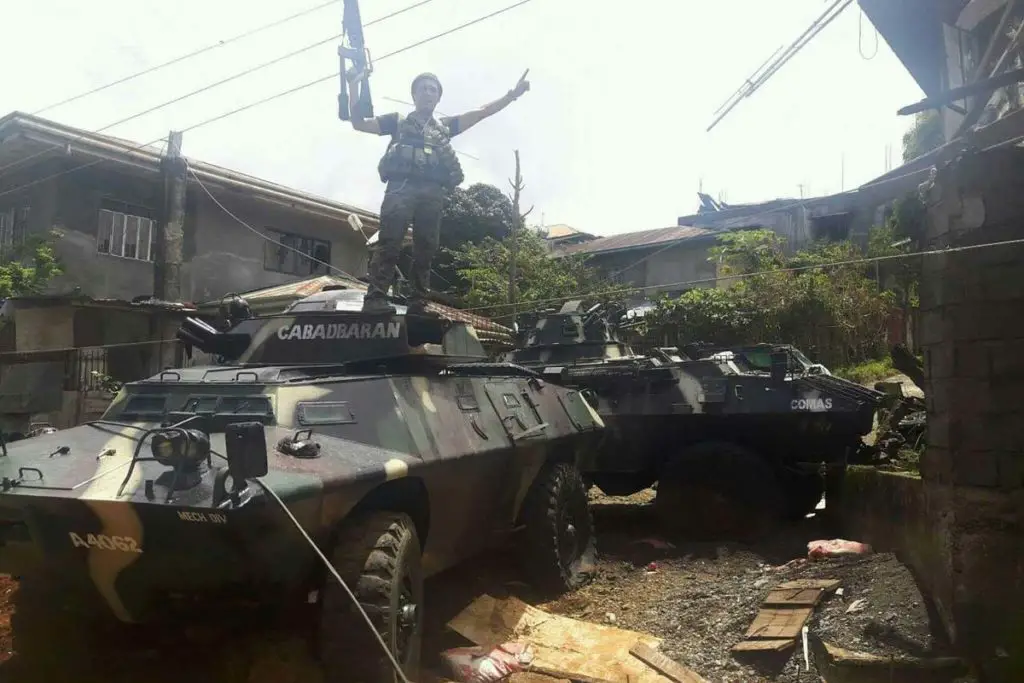
ISIS militants with captured armored vehicles in Marawi, the Philippines. Image: @Terror_Monitor/Twitter
Poor intelligence gathering and assessment
The poor gathering and assessment of intelligence was a key reason for the Philippines underestimating ISIS.
Indonesia’s Defense Minister Ryamizard Ryacudu recently described an exchange he had when he traveled to the Philippines on June 6, 2017, shortly after the start of the Battle of Marawi.
He said he was told by unnamed Philippine officials that there were only 50 militants in Marawi, supported by up to 500 men from drug cartel networks. After the battle, Philippine officials said more than 900 militants had been killed, highlighting that they were clearly underestimating the strength of ISIS both in public and in private.
Not only did Philippine officials not have the intelligence information to more accurately assess the strength of militants in Marawi, but they completely misjudged their nature. They were not men from “drug cartel networks” but loyal ISIS militants, willing to fight to the death for their cause.
Shortly before this meeting, Ryacudu said that Indonesia estimated there were 1,000 to 1,200 ISIS militants in the Philippines. Considering that over 900 fighters were apparently killed in Marawi, and that multiple other groups were not active in the battle, this estimate seems broadly accurate.
In response to that statement, Philippine Defense Undersecretary Ricardo David said the number was new to him.
“I really don’t know, my figure is about 250-400, a lot less,” David said.
Not only does this illustrate the apparent inability of the government to accurately assess the threat from ISIS, but it showcases that even foreign countries had managed to achieve a more accurate assessment.
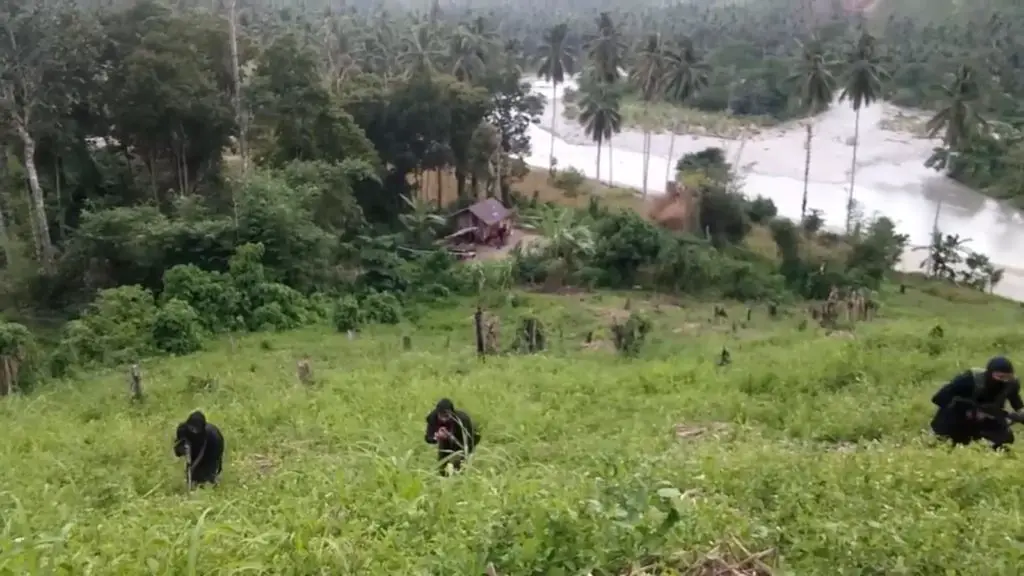
An ISIS training camp in the Philippines, taken from a video released in December 2015. Image: Long War Journal
Intelligence failures
Speaking more generally, Ryacudu also expressed disappointment in Philippine intelligence-gathering and sharing as well as country’s assessment of the threat from ISIS. He said he believed that that “governments underestimated the extent of the IS threat in our region.”
Even more damningly, Ryacudu said that with better use of intelligence the Battle of Marawi “could have been prevented or pre-empted.”
In the aftermath of major terrorist incidents it would repeatedly be revealed that the Philippines had failed to act on intelligence that should have prevented or prepared them for attacks. There was a pattern of failing to assess intelligence, suggesting officials underestimated the actual danger.
In fact, there had been repeated intelligence pointing towards an attack in Marawi in the month leading up to the battle.
The AFP’s Año has stated that intelligence had been received about armed men entering the city. He also said that commanders on the ground had failed to assess intelligence. Major General Rolando Bautista, commander of forces in Marawi, said the military had even received information saying that terrorists would seize the city.
It was only when following up on both this intelligence and reports that the leaders of the Maute group were in Marawi that they discovered Hapilon, the most important ISIS commander in the Philippines, was also there. Bautista immediately decided to capture him, ordering the failed raid that triggered the seizure of the city.
While Marawi is the most prominent example of the Philippines underestimating ISIS and having issues with gathering and following up on intelligence, it is not the only one.
The April 2016 Basilan clash that killed 18 soldiers was a well-prepared ambush. Militants attacked from high ground and all sides using various weapons, including mortars and grenade launchers. The soldiers also had to contend with improvised explosive devices planted by militants. As well as inflicting high casualties, militants beheaded some of the dead soldiers and captured an unconfirmed quantity of weaponry.
Concerns were raised in the aftermath about the handling of the operation and the AFP’s failure to address the ISIS threat. Two generals speaking anonymously called for a probe and suggested there were serious failings in how the operation was carried out.
“What happened was a failure of leadership from top to bottom” as well as a “failure of intelligence,” one general said.
Officials should have addressed their failings on multiple occasions, but the Battle of Marawi should have been a clear wakeup call.
Marawi did force the Philippine government and security forces to admit some of their failings, but there has been no attempt to rectify them. Both continue to downplay the threat from ISIS, and there are still apparent intelligence failings, with Ryacudu stating on October 4 that since Marawi the flow of intelligence has not been effective and has even become “less accurate.”
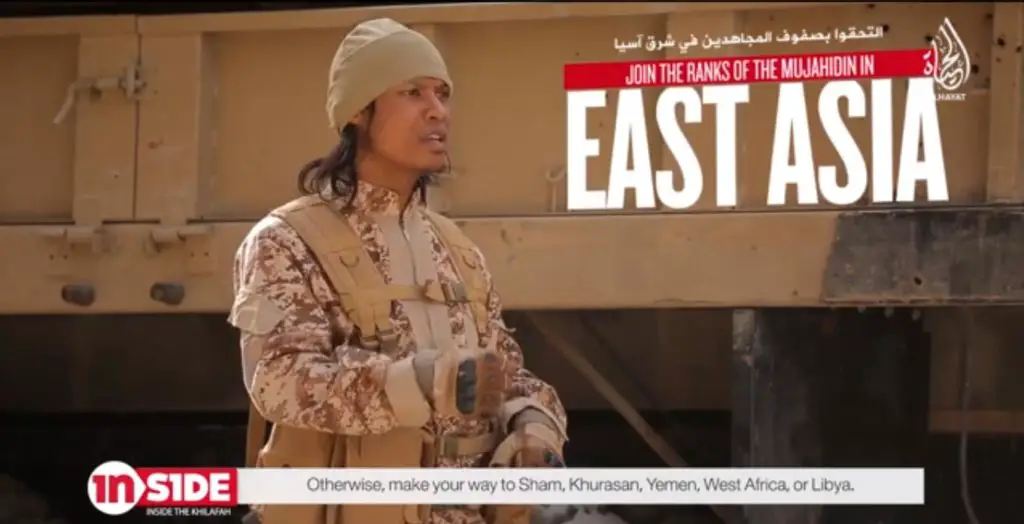
A still from an ISIS propaganda video, calling on people to travel to East Asia to join the group.
‘There is no ISIS-Philippines’
In February the United States designated ISIS-Philippines as a terrorist organization. While the effect of such a designation was welcomed, as it criminalizes providing support and resources to the group and denies access to U.S. financial systems, the concept of an “ISIS-Philippines” was discounted by some Philippine officials.
“There is no ISIS-Philippines,” Defense Secretary Delfin Lorenzana said in March.
Duterte’s spokesperson Harry Roque did acknowledge the presence of ISIS but limited it to just the Maute group.
“That’s ISIS-Maute. I think it’s specific since Maute is known to be the local ISIS,” he said in a statement.
The U.S. designation referred to the whole of the ISIS-affiliated organization in the Philippines. The description referenced the June 2016 ISIS video that featured Hapilon and several other Abu Sayyef militants belonging pledging allegiance to ISIS, and called Maute an “integral part of ISIS-Philippines.”
This July saw arguably the most significant attack by ISIS in the Philippines since Marawi, when a suicide car bomb was detonated at a military checkpoint on Basilan, killing 11 people.
ISIS claimed the attack via their Amaq news agency. The claim stated that it was a suicide attack and named the perpetrator as Abu Khatir Al-Maghribi, a Moroccan. A picture was also released showing the attacker.
In response, AFP spokesperson Colonel Edgardo Arevalo said that there was no indication that ISIS was involved. He said intelligence pointed to Abu Sayyef, and that there was no indication the attacker was a foreigner. He also said there was “no indication that the Basilan blast was a suicide bombing.”
These denials came despite the photographic evidence released by ISIS as well as witnesses who said the driver was a foreigner, and the group responsible was also behind the 2016 Basilan clashes.
Almost two weeks after the attack Lorenzana finally stated that it was believed the attacker was Moroccan, but he still downplayed the possibility of it being a suicide attack and denied that ISIS was involved.
There had also been reports that intelligence had warned about the bombing before it occurred.
A government intelligence report reportedly stated that as early as June 19 officials were aware of a plan to carry out a bombing at any time in Lamitan, the area of Basilan where the attack took place. The day before the bombing there were reports of Malaysian militants arriving on the island, who are now believed to be connected to the attack. Finally, the AFP had intelligence reports that a van containing explosives would pass by Lamitan City.
Like Marawi, despite receiving intelligence pointing towards an imminent attack, authorities had been unable to prevent it.
It has also become common for ISIS groups in the Philippines to be discussed as “remnants” following the Battle of Marawi. This is despite it being over a year since the start of the battle, with the groups involved actively recruiting since. Other ISIS factions – such as BIFF – also had minimal involvement in the battle, meaning their operational strength was not significantly affected by the fighting. Meanwhile, ISIS has upgraded their East Asia region including the Philippines to an official Wilayat, or province, and increased propaganda releases about the Philippines.
The Philippine government and security forces knowingly released inaccurate statements about the threat from ISIS, downplaying the dangers in an attempt to not legitimize the group and to maintain foreign investment and faith in the Philippine economy. The Battle of Marawi and the declaration of martial law that followed shattered both of those justifications.
Yet this downplaying continues to be a tactic used by the Philippine government and the AFP despite its ineffectiveness and role in leading to the genuine underestimation of ISIS’s true strength. The repeated intelligence failings that plagued operations against the group were and still are a key factor in that inaccurate assessment.
Like many instances before it, the Battle of Marawi should have seen the Philippine government and security forces address their failings in the interest of preventing another such attack, yet they appear to continue to make those same mistakes.
Those mistakes come at the expense of security personnel and civilians caught up in the next preventable ISIS attack.
[See also Passport to jihad: European foreign fighters joining ISIS in the Philippines
https://thedefensepost.com/2018/09/12/philippines-isis-foreign-fighters-europe/]
https://thedefensepost.com/2018/10/22/how-the-philippines-underestimates-isis/

No comments:
Post a Comment
Note: Only a member of this blog may post a comment.